Solar energy is growing at an unprecedented rate. In 2023 alone, global solar power capacity surpassed 1.3 terawatts, marking a 25% increase from the previous year. As governments and businesses push for cleaner energy solutions, solar structures have become a crucial component in maximizing efficiency and ensuring long-term reliability. But what exactly is a solar structure, and why does it matter?
A well-designed solar structure does more than just hold panels in place. It influences energy output, system durability, and even maintenance costs. With advancements in materials, such as corrosion-resistant alloys and smart tracking systems, solar mounting solutions are becoming more adaptive and efficient than ever. Yet, many solar investors and project developers underestimate the impact that the right structure can have on their system’s overall performance.
In this guide, we’ll break down everything you need to know about solar structures—their types, materials, design considerations, and installation process—so you can make informed decisions that maximize your return on investment. Whether you’re installing solar on a rooftop, open field, parking lot, or even water surfaces, understanding the right structure is key to building a system that lasts for decades.
What is a Solar Structure?
A solar structure is a specialized framework designed to support and secure solar panels for optimal sunlight exposure. More than just a mounting system, it plays a key role in system stability, energy efficiency, and long-term durability. A well-designed structure can reduce maintenance costs and improve power generation efficiency by minimizing shading and heat buildup.
Also known as:
- Solar mounting systems
- Solar racking systems
- Solar panel support structures
- PV mounting systems
Solar mounting structures vary based on installation environments, from rooftops and open fields to water surfaces. Advances in materials and design, such as lightweight alloys and tracking systems, continue to improve their performance and adaptability. Choosing the right structure is essential for maximizing return on investment and ensuring the longevity of a solar energy system.
Key Features of Solar Structures
A solar structure is more than a frame; it affects the system’s efficiency, durability, and maintenance. The right structure ensures panels stay secure in harsh weather, maximizes sunlight exposure, and reduces long-term costs. Factors like material strength, corrosion resistance, and wind load capacity determine performance. Some designs also offer adjustability and expansion options to meet different project needs.
- Built to withstand strong winds, heavy snow, and seismic activity
- Designed to maximize sunlight capture and improve power generation
- Resistant to rust and material wear for long-term outdoor use
- Compatible with different roof types, open fields, and water surfaces
- Simple assembly process reduces labor costs and time
- Allows fast maintenance with easy access to panels and wiring
- Reduces panel shading and prevents overheating for better efficiency
- Engineered with aerodynamic design for high-wind resistance
- Supports adjustable tilt angles for different sunlight conditions
- Lightweight options available for easy transport and installation
- Customizable designs for residential, commercial, and utility-scale projects
- Supports future system expansion for increased capacity
- Integrated cable management system ensures safety and clean layout
- Includes grounding options to enhance electrical safety
- Designed with drainage features to prevent water accumulation
- Uses recyclable materials for sustainable and eco-friendly applications
- Built to prevent system failures and ensure decades of performance
7 Common Types of Solar Mounting Structures
Solar structures come in different designs to suit various installation environments. Choosing the right type depends on factors like available space, structural support, budget, and energy goals. Each type has unique benefits and limitations.
Ground-Mounted Solar Structures

If you have open land available, a ground-mounted solar structure might be your best option. Unlike rooftop systems, these structures don’t rely on buildings for support. Instead, they are installed directly on the ground, allowing full control over panel orientation and tilt to capture the most sunlight.
There are two common installation methods. In stable soil, steel piles are driven directly into the ground for a secure foundation. In rocky or uneven terrain, concrete foundations provide extra stability. These systems are often used for solar farms, commercial projects, and off-grid energy solutions.
One key advantage is better airflow around the panels, which helps keep them cool and improves efficiency. They are also easier to clean and maintain since everything is at ground level. However, they do require land space and may involve higher installation costs due to groundwork.
Pros:
- Maximizes energy production with adjustable tilt angles
- Better cooling for panels, improving efficiency
- Works well for large-scale solar farms and commercial projects
- Flexible installation on different types of terrain
Cons:
- Requires dedicated land space
- Higher installation costs due to site preparation
- Local regulations may limit land use for solar installations
Roof-Mounted Solar Structures

If you want to go solar but don’t have extra land, a roof-mounted system is a great choice. These structures are installed directly on rooftops, making use of existing space without taking up valuable ground area. They are popular for homes, businesses, and industrial buildings looking to reduce electricity costs.
There are two main types of roof-mounted systems. Fixed-tilt systems keep panels in place at a set angle, while adjustable or ballasted systems allow slight modifications for better sunlight exposure. The structure is designed to be lightweight yet strong, ensuring it doesn’t overload the roof.
One key benefit is that rooftop solar helps protect the roof from direct sun exposure, which can extend its lifespan. However, installation depends on roof strength, available space, and orientation. Older or weak roofs may need reinforcement before installation.
Pros:
- Uses existing space, no extra land required
- Reduces energy costs by generating power on-site
- Provides shade and protects the roof from direct sun exposure
- Lower installation costs compared to ground-mounted systems
Cons:
- Limited by roof size, angle, and structural strength
- May require reinforcement for older or weak roofs
- Access to maintenance can be more challenging
Floating Solar Structures

Solar panels don’t always need to be on land. Floating solar structures are installed on water surfaces like lakes, reservoirs, and industrial ponds, turning unused water space into a renewable energy source. These systems use floating platforms to hold the panels in place while staying stable in changing water levels.
One major advantage is cooling. Water naturally lowers the temperature of the panels, helping them operate more efficiently, especially in hot climates. Floating solar also reduces water evaporation and slows algae growth, making it beneficial for water management.
However, these systems require specialized anchoring to handle wind and waves, and installation is more complex than land-based solar. They are best suited for locations with limited land availability and high solar potential.
Pros:
- Uses water surfaces, preserving valuable land space
- Improves panel efficiency by keeping them cooler
- Reduces water evaporation and prevents excessive algae growth
- Ideal for large-scale energy production in water-rich regions
Cons:
- Requires specialized anchoring and engineering
- More expensive to install and maintain than traditional systems
- Accessibility for repairs and cleaning can be challenging
Tracking Solar Structures
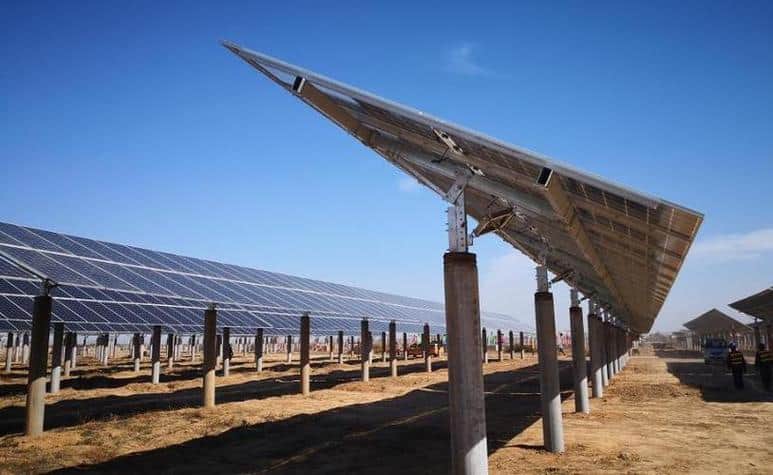
Not all solar panels stay in a fixed position. Tracking solar structures are designed to follow the sun’s movement throughout the day, capturing more sunlight and increasing energy production. These systems use motors and sensors to adjust panel angles, ensuring they are always positioned for maximum efficiency.
There are two main types: single-axis trackers, which move panels from east to west, and dual-axis trackers, which adjust both vertically and horizontally for even greater solar exposure. While these systems significantly boost energy output, they come with added complexity. Moving parts mean higher maintenance needs, and the initial investment is greater than fixed structures.
Tracking solar is often used in utility-scale solar farms where maximizing energy production justifies the extra cost. It’s less common for residential and small commercial projects due to space and budget considerations.
Pros:
- Increases solar energy capture throughout the day
- Higher energy yield compared to fixed structures
- Adapts to seasonal and daily sun position changes
Cons:
- More expensive due to motors and tracking technology
- Requires regular maintenance for moving parts
- Less suitable for small-scale installations due to space and cost
Solar Carport Structures
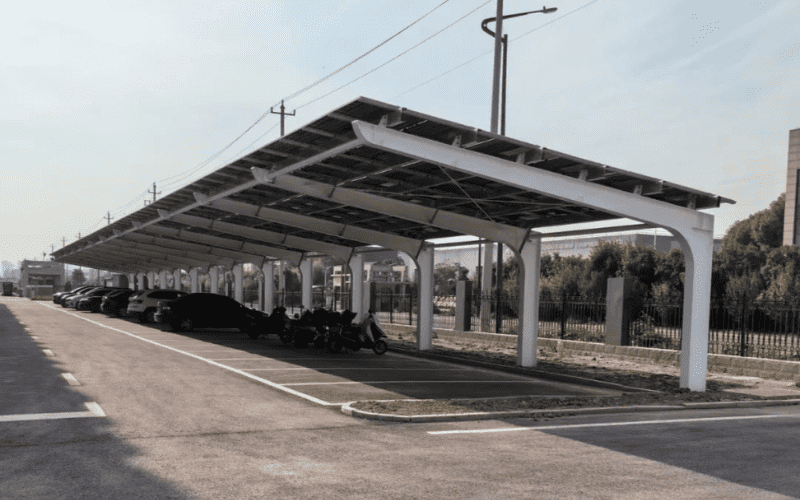
A solar carport turns an ordinary parking lot into a power-generating asset. Instead of leaving cars exposed to the sun, this structure provides shade while producing clean electricity. It’s a practical way for businesses, shopping centers, and public spaces to reduce energy costs without using extra land.
Beyond just shading vehicles, solar carports offer real-world benefits. Cars parked underneath stay cooler, improving comfort and reducing AC use. Businesses can also install EV charging stations, allowing customers and employees to charge their cars with solar power. For companies focused on sustainability, solar carports are a visible statement of clean energy commitment.
The design can be adjusted to fit different parking layouts, but installation requires a strong foundation to handle wind and snow loads. While upfront costs are higher than traditional ground-mounted systems, the long-term savings and multi-purpose benefits make them an efficient use of space.
Pros:
- Turns parking areas into solar energy sources
- Provides shade, keeping vehicles cooler and more comfortable
- Reduces energy costs while maximizing space efficiency
- Can integrate EV charging for added functionality
Cons:
- Requires a solid structural foundation for stability
- Higher upfront investment compared to standard ground-mounted systems
- Local regulations may affect design and permitting
Solar Canopy & Specialty Solar Covers
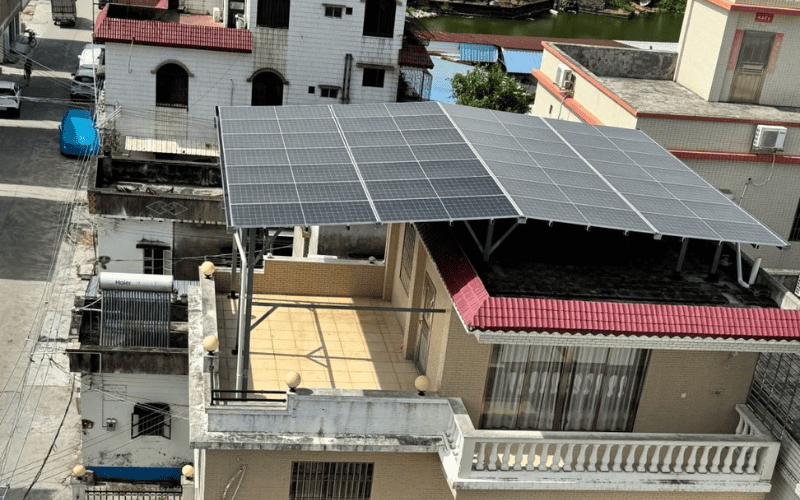
Solar structures don’t have to be limited to rooftops or parking lots. Solar canopies and specialty solar covers offer a flexible way to generate power while providing shade and weather protection in public and private spaces. From walkways and patios to bike paths and bus stops, these structures combine functionality with clean energy generation.
A solar canopy is similar to a carport but can be installed over almost any open space. Businesses use them in outdoor seating areas, while cities install them along sidewalks and bike paths. EV charging canopies are growing in popularity, allowing vehicles to recharge using solar power.
For homes, solar patio covers, pergolas, and gazebos add both aesthetics and functionality, turning outdoor spaces into shaded, energy-producing areas. In commercial and public settings, solar walkway canopies and bus shelters create comfortable shaded zones while supplying power for lighting, charging stations, or grid integration.
Since these structures vary in size and function, design flexibility is key. While they make excellent use of existing spaces, they require careful engineering to ensure stability and optimal energy production.
Pros:
- Adds solar power generation to otherwise unused open spaces
- Provides shade and weather protection for people and vehicles
- Works well for public spaces, businesses, and residential areas
- Supports additional functions like lighting, charging stations, and seating areas
Cons:
- Requires custom design for each specific use case
- Structural reinforcement may be needed for larger installations
- Installation costs vary depending on location and intended use
Solar Greenhouse Structures
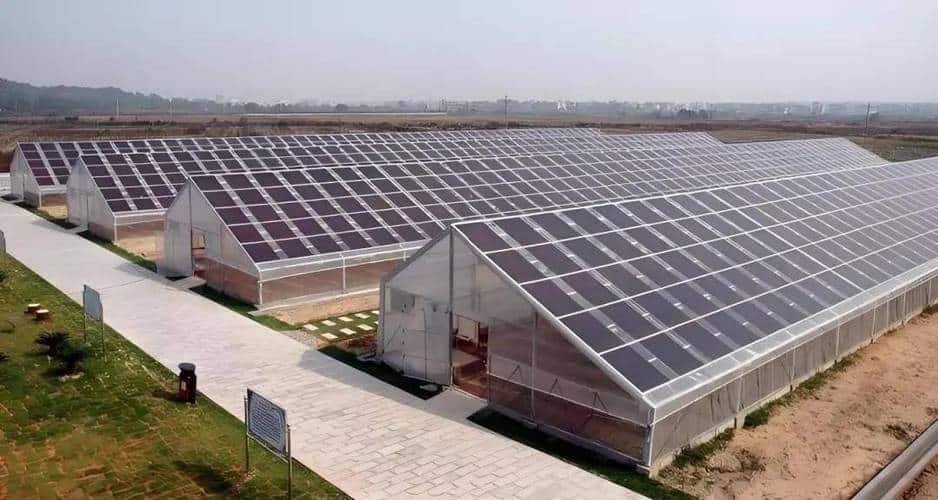
A solar greenhouse combines crop production with clean energy generation, using specially designed panels that allow both sunlight and power production. This system helps farmers reduce electricity costs, improve sustainability, and create energy-independent operations.
Instead of blocking sunlight completely, semi-transparent panels or adjustable PV modules ensure plants get the right amount of light while generating solar energy. Some designs use dynamic shading to balance plant growth and energy production throughout the day.
Solar greenhouses power irrigation, ventilation, and climate control systems, cutting operational costs and making farming more efficient. They are especially valuable in areas with high energy prices or unreliable power grids.
Proper design is crucial, as different crops require varying light levels. While initial costs are higher, long-term energy savings and stability make it a strong investment for farms.
Pros:
- Generates clean energy while supporting plant growth
- Reduces farm electricity costs and improves sustainability
- Can power irrigation, ventilation, and climate control systems
- Provides energy security in areas with unreliable power
Cons:
- Requires careful panel placement to balance light and power generation
- Higher upfront cost than standard greenhouses
- Best suited for crops that can tolerate partial shading
Related Reading:
Should You Build a Solar Greenhouse? Key Benefits and Drawbacks
Common Materials for Solar Structures
The strength and lifespan of a solar structure depend on the materials used. A good material choice ensures durability, corrosion resistance, and cost-effectiveness. The most common materials include:
- Galvanized Steel – Strong and long-lasting. It has high load capacity and resists rust, making it ideal for large solar farms and ground-mounted systems.
- Aluminum – Lightweight and rust-resistant. Often used for rooftop systems where reducing weight is important.
- Stainless Steel – Highly resistant to rust and extreme weather. Best for coastal and humid areas where corrosion is a concern.
- Hot-Dip Galvanized Iron – A more affordable option than stainless steel. Provides moderate rust resistance for standard environments.
- Composite Materials – Used in special cases for a mix of strength, flexibility, and durability.
The right material depends on factors like climate, location, weight limits, and budget. Choosing wisely helps extend system life and reduce maintenance costs.
What is the Best Material for Solar Structures?
The best material depends on where and how the solar structure will be used:
- For large solar farms and ground-mounted systems → Galvanized Steel for its high strength, low cost, and ease of installation.
- For residential and rooftop systems → Aluminum for its lightweight, rust resistance, and minimal roof load.
- For coastal, humid, or extreme weather areas → Stainless Steel to withstand corrosion and harsh conditions.
- For standard environments with budget limits → Hot-Dip Galvanized Iron as a durable and affordable alternative.
- For special designs needing flexibility → Composite Materials for a balance of strength, adaptability, and durability.
Selecting the right material ensures long-term performance and cost savings. For large projects or extreme conditions, consulting an expert can help you choose the most durable and cost-effective solution.
Solar Structure Design
A well-designed solar structure ensures stability, efficiency, and long-term reliability. Several key factors must be considered to maximize energy output and reduce maintenance costs.
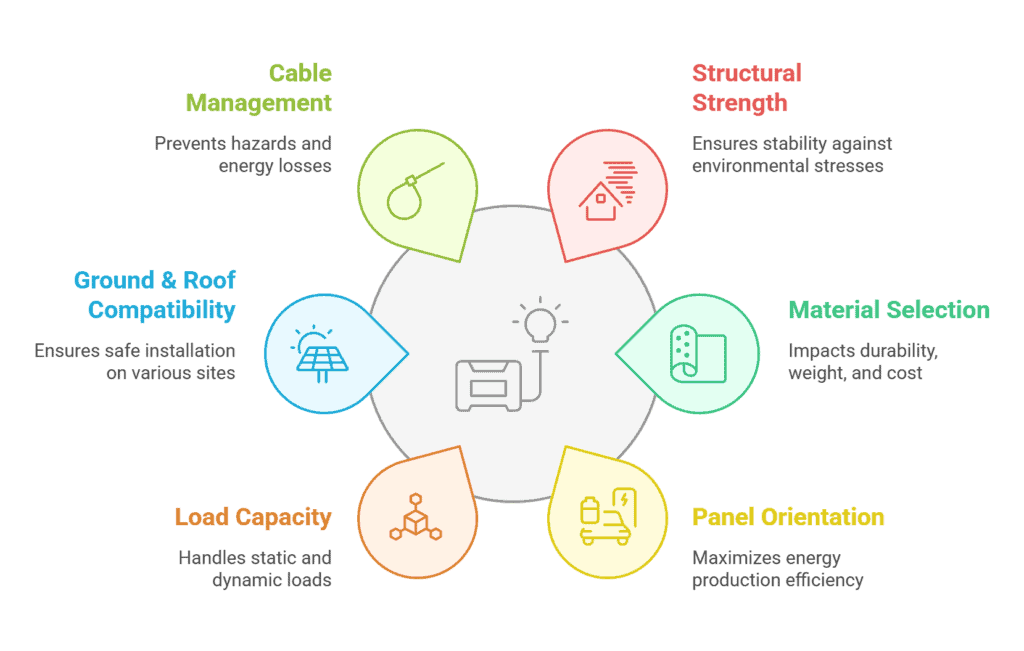
Structural Strength
A solar structure must withstand environmental stress like strong winds, heavy snow, and seismic activity. Proper load calculations ensure the frame remains stable without excessive material costs. In high-wind zones, reinforced foundations and aerodynamic designs prevent structural failure. For rooftop systems, the roof’s weight capacity must be assessed to avoid overloading.
Material Selection
The choice of materials impacts durability, weight, and cost. Galvanized steel offers strength for large installations, while aluminum provides a lightweight, corrosion-resistant option for rooftops. Stainless steel is ideal for humid or coastal areas where rust is a concern. Choosing the right material ensures long-term performance with minimal maintenance.
Panel Orientation & Tilt Angle
The direction and angle of solar panels directly affect energy production. South-facing installations (in the Northern Hemisphere) and north-facing ones (in the Southern Hemisphere) capture the most sunlight. The tilt angle should match the site’s latitude for optimal efficiency, while adjustable or tracking systems can further boost output in large projects.
Load Capacity & Wind Resistance
A structure must be designed to handle static loads (panel weight) and dynamic loads (wind, snow, and seismic forces). In storm-prone areas, deep foundations and aerodynamic designs reduce wind uplift. Snowy regions require higher load-bearing capacity to prevent structural stress. Proper engineering prevents failures and reduces long-term repair costs.
Ground & Roof Compatibility
Different sites require different designs. Ground-mounted systems need stable foundations, with driven piles for firm soil and concrete bases for rocky terrain. Rooftop systems must consider roof angle, structural strength, and available space to ensure safe installation without damaging the building.
Cable Management & Electrical Safety
Poor cable organization can cause safety hazards, energy losses, and maintenance issues. A well-designed structure includes protected cable trays, organized wiring routes, and grounding systems to improve system efficiency and prevent electrical faults.
Ease of Installation & Maintenance
A practical design speeds up installation and reduces labor costs. Pre-assembled components and modular designs make the process faster. Accessibility is also key—structures should allow easy panel cleaning, wiring checks, and future system expansion without complex disassembly.
The right structure protects your investment and ensures long-term efficiency. Whether for a rooftop, ground-mounted, or custom solar project, choosing the correct design can significantly impact performance and cost savings.
Need expert guidance? Our team specializes in designing solar structures that fit your needs. Reach out to us for a free design consultation.
Related Reading:
Maximizing Solar Efficiency Through Smart Structure Design
Solar Structure Installation
A successful solar installation requires more than just placing panels on a frame. Each step needs to be carefully planned and executed to ensure stability, efficiency, and long-term reliability. Here’s what the process looks like:
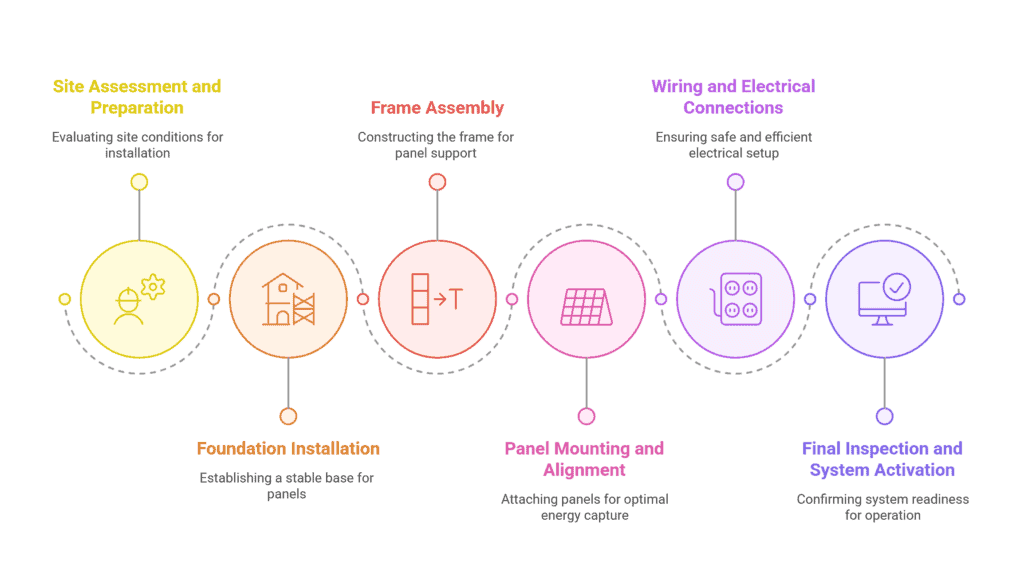
1. Site Assessment and Preparation
Before installation begins, the site must be evaluated. Soil conditions, wind exposure, and roof strength all affect the type of structure needed. For businesses and homeowners, proper planning at this stage helps avoid unexpected delays and ensures the structure meets both energy needs and local regulations.
2. Foundation Installation
For ground-mounted systems, the foundation is critical for stability. In solid soil, steel piles are driven deep into the ground. For rocky or loose soil, concrete footings may be necessary. Rooftop installations require secure mounting points to prevent damage to the building while ensuring long-term support.
3. Frame Assembly
Once the foundation is set, the frame is built. This step ensures proper weight distribution, alignment, and tilt angle to optimize sunlight exposure. Well-assembled structures reduce strain on the panels and improve system efficiency.
4. Panel Mounting and Alignment
Solar panels are attached to the frame with precise spacing to maximize energy capture and prevent shading issues. If a tracking system is used, mechanical adjustments ensure the panels can follow the sun’s movement smoothly.
5. Wiring and Electrical Connections
Proper electrical setup is key to safety and performance. Cables are neatly organized and securely connected to prevent damage or energy loss. Grounding, surge protection, and weatherproofing are also handled to ensure long-term reliability.
6. Final Inspection and System Activation
Before the system goes live, a final check is performed. Structural stability, panel alignment, and electrical connections are all tested to confirm everything is working as expected. After approval, the system is officially activated, and ready to produce clean energy.
Build a Solar Structure That Lasts – Start Today
The right solar structure maximizes energy efficiency and system lifespan. With precision-engineered designs, in-house steel fabrication, and expert installation support, we ensure every component meets the highest standards.
Get a free custom design and professional consultation to optimize your solar project. From 2D and 3D blueprints to on-site installation guidance, we provide full-process support to streamline your build.
Talk to our experts today and get a tailored solution for your solar project.
FAQs
What is the difference between L2 and L3 structure?
L2 (Level 2) structures are standard solar mounting systems designed for typical environmental conditions, while L3 (Level 3) structures are reinforced for extreme conditions, such as high wind, heavy snow, or seismic zones.
What are Tier 2 solar panels?
Tier 2 solar panels are manufactured by mid-sized companies with decent quality but less automation and vertical integration than Tier 1 brands. They offer a balance between cost and reliability but may have shorter warranties or less financial backing.
What are solar cell structures?
Solar cell structures refer to the layers and materials used in photovoltaic (PV) cells to convert sunlight into electricity. This includes semiconductors (like silicon), anti-reflective coatings, and electrical contacts to optimize energy conversion.
What is meant by solar building?
A solar building is a structure designed to generate or optimize solar energy use, either through active solar systems (like PV panels) or passive solar design (like strategic window placement for natural heating and cooling).
What is the meaning of solar architecture?
Solar architecture integrates solar energy technologies into building design to maximize efficiency. It includes solar panels, passive solar heating, energy-efficient materials, and shading techniques to reduce reliance on non-renewable energy.
What are the 5 elements of passive solar design?
- Aperture (Collection) – South-facing windows capture sunlight.
- Absorber – Dark surfaces inside absorb solar heat.
- Thermal Mass – Materials like concrete or stone store heat.
- Distribution – Heat spreads naturally via conduction, convection, or radiation.
- Control – Roof overhangs, vents, and shades regulate heat intake.

